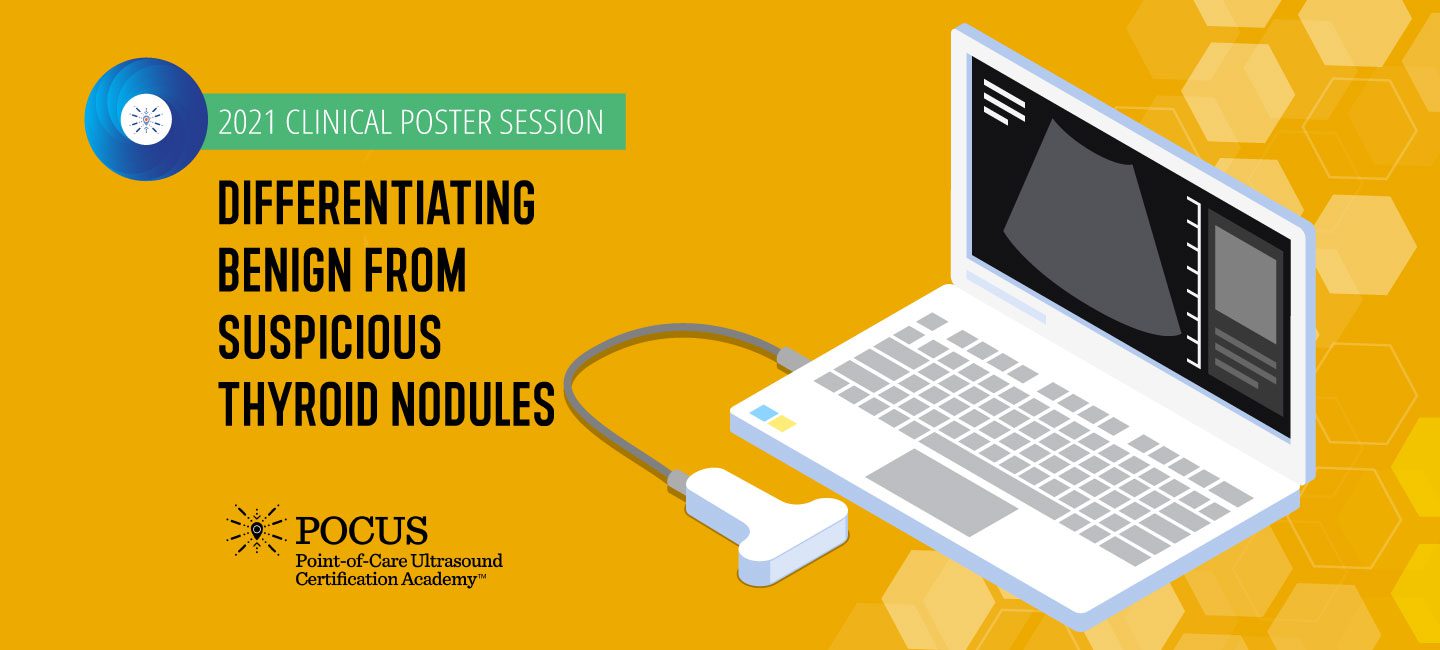Dr. Timothy J. Yu, Associate Program Director, VCU-Bon Secours Family Medicine Residency Program, hosted a compelling poster session at the 2021 World POCUS Conference. Doctor, There’s a Lump in My Throat: Differentiating Benign from Suspicious Thyroid Nodules walks attendees through the importance of accurately and timely diagnosing the appearance of a bulge, particularly a growing bulge, in the throat. Point-of-care ultrasound (POCUS) aided Dr. Yu with the prognosis and treatment of the cancerous discovery. This blog details how imaging is used to do so.

This solid or fluid-filled lump found within the throat is usually located within the thyroid, medically termed as a thyroid nodule. Most aren’t serious in nature and are asymptomatic, but a small percentage of thyroid nodules are cancerous. Generally, nodules are usually too small to be visible to the naked eye. Many are discovered during routine medical exams or when a scan is conducted for a different health reason. When thyroid nodules are large enough, they become visible or create difficulty swallowing or breathing.
The ultimate goal in assessing a thyroid nodule is to rule out cancer. Additionally, the evaluation is also used to determine if the thyroid is functioning adequately. Testing consists of a physical exam, thyroid function tests, thyroid scan, ultrasound, and/or a fine-needle aspiration biopsy. The most common referral is for an ultrasound evaluation. It provides a safe and fast examination method. Ultrasound is sensitive enough to detect thyroid nodules and examine suspicious features to guide further investigation and management decisions.
Knowing the various features associated with a benign thyroid nodule versus a cancerous one is imperative. It allows swift, efficient, and fiscal decisions to be formulated regarding the patient’s care. It is essential to understand sonographic patterns of benign, suspicious, and malignant nodules to properly diagnose and treat. The British Thyroid Association (BTA) recently created an ultrasound classification of thyroid nodules to facilitate appropriate care plans.
Before becoming proficient in identifying abnormalities, a prerequisite required is familiarity with the normal sonographic appearance of the thyroid gland relative to its surrounding structures. A normal thyroid gland is homogeneous and mildly hyper-echogenic compared to surrounding muscle. Thyroid lobes have a globular shape with a smooth outline. On ultrasound, nodules distort the homogeneous echo pattern of the thyroid gland and are depicted as discrete lesions. The carotid arteries present as round hypo-echogenic tubular structures located laterally to each thyroid lobe. The paired internal jugular is further lateral to the carotid arteries. Additional vessels are echo-free thinner vessels within and around the perimeter of the thyroid gland. The strap and sternocleidomastoid muscle wrap around the anterior aspect of the thyroid gland. They have a lower echo signal relative to the thyroid.
The lymph nodes, nerves, and esophagus are other identifiable regional structures surrounding the thyroid.
This foreknowledge allows identifying opposing characteristics on ultrasound to help distinguish benign from malignant nodules. Never use size and the number of nodules for disease differentiation, as the better identifier is nodular morphology.
Benign thyroid nodules exuberate the following morphologic characteristics:
- The nodule’s echo signal should be the same or slightly hyper-echogenic relative to the surrounding thyroid tissues.
- The nodule may have a hypo-echogenic halo, representing fibrous connective tissue that is compressed thyroid tissue and vessels.
- Nodules cystic in appearance contain a hyper-echogenic spot with a ‘comet-tail’ shadowing or a ‘ring-down’ sign, representing colloids.
- A spongiform or honeycomb consistency with dark micro-cystic space of the nodule with a specificity of 99.7% is considered benign, while a 98.5% negative predictive value is deemed malignant.
Suspicious thyroid nodules should be examined further by performing a fine-needle aspiration biopsy. These nodules consist of the following:
- The hypo-echogenicity or echo signals of the nodule are less than the surrounding normal thyroid tissue.
- The nodules are both hypo-echogenic and predominantly solid in consistency.
- A nodule with a disrupted eggshell calcification around the peripheries or has lost its smooth round contour while adopting a lobulated margin is classified as suspicious.
The features on an ultrasound that suggests a malignant thyroid nodule include:
- The nodule is hypo-echoic on the ultrasound compared to the adjacent normal thyroid tissue.
- The nodule is taller than wide in shape (the anteroposterior (AP) diameter is more than the transverse (TR) diameter).
- When the nodule has an irregular shape accompanied by irregular edges.
- Malignant thyroid nodules usually demonstrate intranodular vascularity.
It is imperative to note that using a single imaging feature to differentiate between benign and malignant nodules is not recommended. The nodule’s collective qualities and overall appearance should be taken into consideration to determine the need for further examination and tests.





















